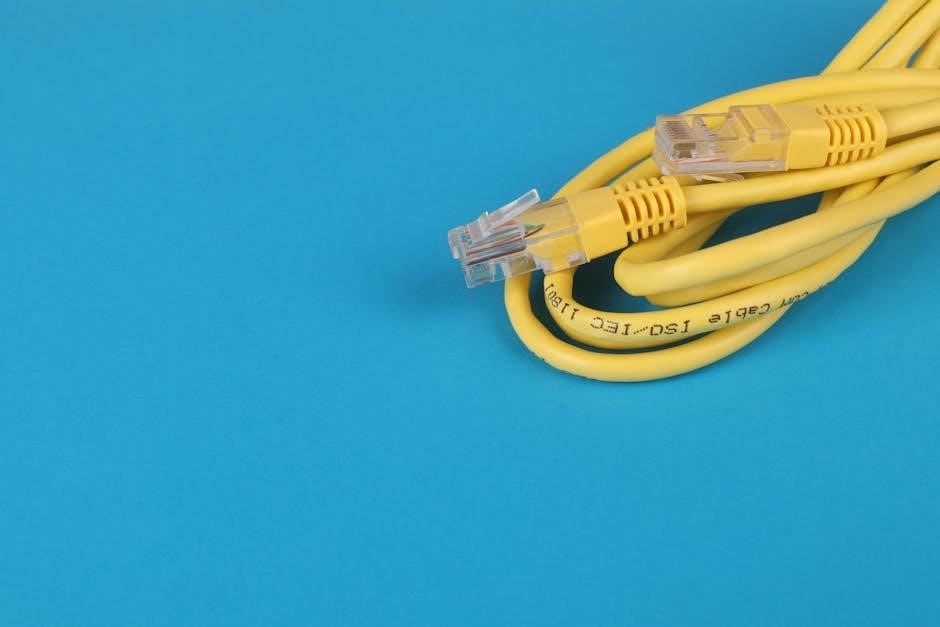Understanding the Basics of Ethernet Cables
To understand the basics of Ethernet cables, it is essential to know that they are used to connect devices to a local area network (LAN) or wide area network (WAN). The cables consist of eight wires, each with a specific color code, which are used to transmit data. The color code is crucial in ensuring that the cables are connected correctly, and the data is transmitted efficiently. The Ethernet cable color code PDF guide provides a comprehensive overview of the color codes and their corresponding wire sequences. By understanding the basics of Ethernet cables, individuals can easily install, maintain, and troubleshoot their network connections. The guide is available for free download and can be used as a reference for networking professionals and individuals who want to learn more about Ethernet cables. The color code is an essential aspect of Ethernet cables, and understanding it is vital for ensuring reliable network connections. The guide provides detailed information on the color codes and their applications.

Types of Ethernet Cables and Their Color Codes
RJ45, PoE, Cat5, and Cat6 Cable Color Codes
Ethernet cable color codes are essential for identifying and connecting different types of cables, including RJ45, PoE, Cat5, and Cat6. The RJ45 connector is commonly used with Ethernet cables, while PoE allows for power and data transmission over the same cable. Cat5 and Cat6 cables have different data rate capabilities, with Cat6 being the faster of the two. Understanding the color codes for these cables is crucial for installing and maintaining Ethernet networks. A free PDF guide is available for download, providing detailed information on the color codes for each type of cable. The guide includes diagrams and instructions for mastering the art of networking. By following the color codes and guidelines outlined in the PDF, technicians can ensure reliable and efficient connections. The color codes are part of the industry standard, making it easier to work with different types of Ethernet cables.

LAN Cable Color Code PDF Guide
Comprehensive Guide to T568A and T568B Color Codes

Importance of Ethernet Cable Color Coding Standards
TIA/EIA-568-A and TIA/EIA-568-B Wiring Standards
The TIA/EIA-568-A and TIA/EIA-568-B wiring standards are two widely used standards for Ethernet cable color coding, providing a framework for organizing and connecting cables. These standards specify the order of the eight wires in an Ethernet cable and their associated colors, with the main difference being the placement of the orange and green pairs. The TIA/EIA-568-A standard is the most commonly used, but the TIA/EIA-568-B standard is also widely accepted. Both standards ensure that Ethernet cables are compatible and can be used in a variety of networking applications. By following these standards, technicians can ensure reliable and efficient network connections. The use of these standards also makes it easier to troubleshoot and maintain network cables, reducing downtime and improving overall network performance. These standards are essential for anyone working with Ethernet cables and are widely available in PDF format for easy reference.

Practical Applications of Ethernet Cable Color Codes
Ethernet cable color codes have numerous practical applications in real-world scenarios, including network installation and maintenance. The use of standardized color codes enables technicians to quickly identify and connect cables, reducing the risk of errors and downtime. In addition, color-coded cables can be easily organized and managed, making it simpler to troubleshoot and repair network issues. The practical applications of Ethernet cable color codes also extend to the installation of new network infrastructure, where they can help ensure that cables are properly connected and configured. Furthermore, the use of color-coded cables can improve network security by making it more difficult for unauthorized individuals to access or tamper with network cables. Overall, the practical applications of Ethernet cable color codes are essential for ensuring reliable and efficient network operations, and are widely used in a variety of industries and applications, including PDF guides and tutorials.